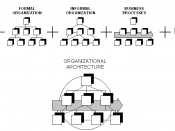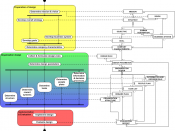More specifically, Organization Design is a formal, guided process for integrating the people, information and technology of an organization. It is used to match the form of the organization as closely as possible to the purpose(s) the organization seeks to achieve. Through the design process, organizations act to improve the probability that the collective efforts of members will be successful.
Typically, design is approached as an internal change under the guidance of an external facilitator. Managers and members work together to define the needs of the organization then create systems to meet those needs most effectively. The facilitator assures that a systematic process is followed and encourages creative thinking.
Hierarchical Systems
Western organizations have been heavily influenced by the command and control structure of ancient military organizations, and by the turn of the century introduction of Scientific Management. Most organizations today are designed as a bureaucracy in which authority and responsibility are arranged in a hierarchy.
Within the hierarchy rules, policies, and procedures are uniformly and impersonally applied to exert control over member behaviors. Activity is organized within sub-units (bureaus, or departments) in which people perform specialized functions such as manufacturing, sales, or accounting. People who perform similar tasks are clustered together.
The same basic organizational form is assumed to be appropriate for any organization, be it a government, school, business, church, or fraternity. It is familiar, predictable, and rational. It is what comes immediately to mind when we discover that ...we really have to get organized!
As familiar and rational as the functional hierarchy may be, there are distinct disadvantages to blindly applying the same form of organization to all purposeful groups. To understand the problem, begin by observing that different groups wish to achieve different outcomes. Second, observe that different groups have different members, and that each...



Plagiarism detected
The paper is completely plagiarised from: http://www.inovus.com/organiza.htm
0 out of 0 people found this comment useful.